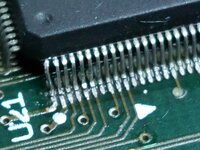ExplorerZ
Well-known member
I guess I did, each side only has about half a millimeter.Surely you didn't break off both sides. The front and back?
Should I press down on it with my soldering iron so it slips through?
I guess I did, each side only has about half a millimeter.Surely you didn't break off both sides. The front and back?
(Other message)Surely you didn't break off both sides. The front and back?
I'm very confused that you don't have anything to grasp on either side of the board, and am almost certain you are misunderstanding me.I guess I did, each side only has about half a millimeter.
Should I press down on it with my soldering iron so it slips through?
Oh ok. I just have a soldering mat on my table that I’m using.I'm very confused that you don't have anything to grasp on either side of the board, and am almost certain you are misunderstanding me.
Melt the solder from the side of the PCB, and push a small wooden skewer into the hole to push the pin out.
Worked, but I’m having trouble clearing out the holes so I can put a new one in.I'm very confused that you don't have anything to grasp on either side of the board, and am almost certain you are misunderstanding me.
Melt the solder from the side of the PCB, and push a small wooden skewer into the hole to push the pin out.
Use flux and solder wick, if you still struggle, counterintuitively, re fill it with solder and try again. Don't hold the iron on it for too long or it will scorch. Lift the wick away with the iron and don't let the solder cool with the wick on the board, and if it does, don't tug on the wick or you might damage a pad or trace.Worked, but I’m having trouble clearing out the holes so I can put a new one in.
Noob question. How would I check the traces? And which ones?How are you checking for those, visually or using a multimeter?
How many SIMMs are installed and what capacities/speed ?
Any help?Noob question. How would I check the traces? And which ones?
Take the board out of the computer and study it in good light. Systematically look at each and every area. It can help to take a photo and draw a grid over it, then inspect each grid square and mark it off before moving on.Any help?
One black trace, probably corroded. Previous owner put a wire jumper on it though and when tested it works. Tested a few random traces and they were all good. Is there any important traces I should test? Where are they?Take the board out of the computer and study it in good light. Systematically look at each and every area. It can help to take a photo and draw a grid over it, then inspect each grid square and mark it off before moving on.
You're looking for damage like chips or scratches or bent pins, or corrosion, which looks like dark patches or mottling, or dull grey solder (instead of shiny). Really bad is green fuzz and black solder.
If you find a suspect area, set the multimeter to "continuity" mode (buzzer mode) if it has one, or resistance mode (the lowest setting) if not. If you're really unfamiliar with multimeters, it's probably best to watch a couple of videos.
Follow each bad looking trace to its start and end, and carefully, without slipping with the probes, check if there is a continuity by putting a probe at each end where there is metal - on a pin or pad.
Do not scratch over the surface of the PCB. Do not slip or press on small pins and bend them.
Have a look for videos on YouTube for continuity testing. It will be much easier than me explaining.
On the PCBOne black trace, probably corroded. Previous owner put a wire jumper on it though and when tested it works. Tested a few random traces and they were all good. Is there any important traces I should test? Where are they?
Which traces should I test? I tried testing the ones near the reset button but I can find where they end.I've had boards where traces look fine but when tested they are no good. Easiest way is the multimeter on continuity mode.
Do you have a image that shows were the traces start and end? It would really help.More seriously, check near the video port, and check the previous repair isn't shorting to something else. But there aren't really shortcuts sorry.
It's in front of you, its green and rectangular! Repairing logic boards isn't quick. It took me 11 months on and off to fix my 630, although there was quite a lot wrong with it and I ignored it for about 9 months in the middleDo you have a image that shows were the traces start and end? It would really help.

Since I have had it, it has powered on, but not chimed. I know the last owner is somewhere on here, so I can ask him. I bought it for parts/repair.Re reading your initial posts, it sounds more fundamental than video. Has it ever booted (since you'vehad it)? Or even chimed?
